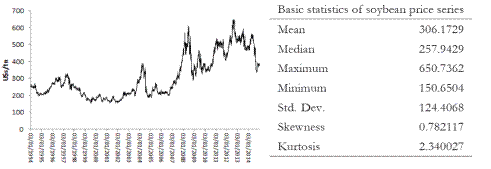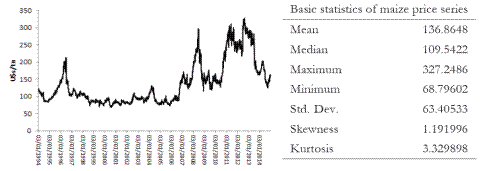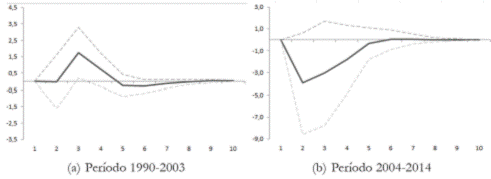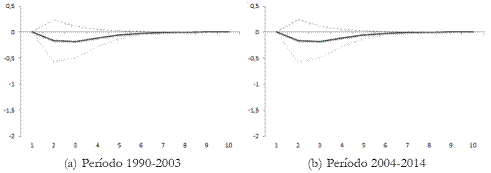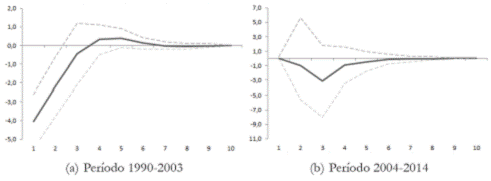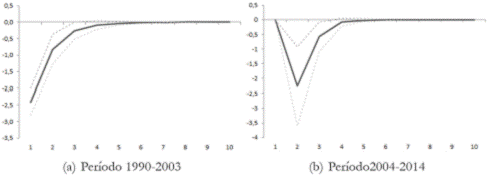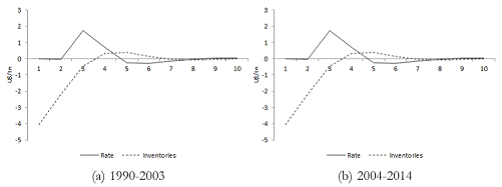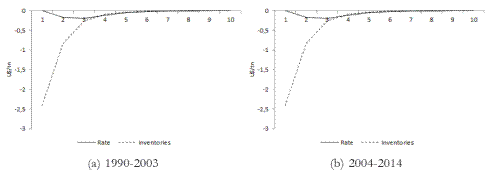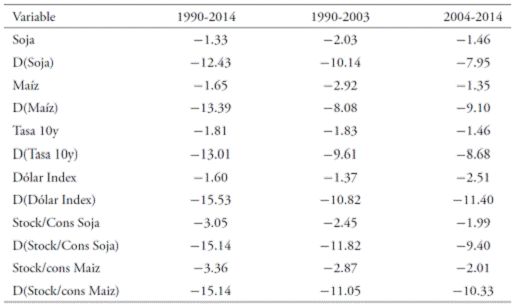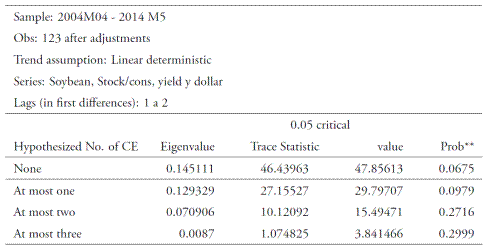Introduction
The decade between 2004 and 2014 has witnessed major changes in commodity markets, exhibiting higher prices and an increase in volatility. Also, a greater presence of portfolio investors as major participants in commodity index positions raises the question of whether the interest rate has a deeper effect on prices compared to fundamental variables, such as commodity inventories. Therefore, the aim of this paper is to explore evidence in order to test if commodities prices have become more sensitive to interest rate changes in the last ten years (2004-2014) compared to the period 1990-2003, and also compared to the incidence of inventories in prices. This study will focus specifically in soybean and maize markets. By means of an autoregressive vector system (VAR), the effect on prices of changes in interest rates and inventories will be tested. Implications for countries heavily reliant on commodity exports will be drawn from the outcomes of this study.
The structure of this paper is as follows. First, some concepts of macroeconomic vulnerability related to commodity export concentration are presented. Second, in order to specify the inputs of the model, the basic relations of the variables that explain movements in commodity prices are introduced. Third, a brief justification of the selected model is presented, followed by the specification of variables, equations and data. Fourth, explanations of the empirical results are presented. Finally, some conclusions are drawn from the macroeconomic vulnerability framework.
I. Macroeconomic vulnerability
It has long been studied that dependence on commodities exports is a factor that increases macroeconomic vulnerability in developing countries. That relationship is based on that those events amplify volatility of the growth rate, reduce the long-run growth rate and breed persistent risk of balance of payment crisis (Bravo-Ortega & De Gregorio, 2005; Ffrench-Davis, 2005; Gala, 2008; Ocampo, 2007; Rodrik, 2008; Briguglio et al., 2009; Frankel, 2010; Guillaumont, 2011; Montalbano, 2011; Canuto & Cavallari, 2012; Céspedes & Velasco, 2012; Seth & Ragab, 2012).
Furthermore, the increasing financial flows liberalization since the 1970s and the skyrocketing process of world financial integration in the last two decades changed the relative weight of economic variables that affect macroeconomic vulnerability from real towards financial ones (Prasad et al., 2003; Ffrench-Davis, 2005 and 2008; Dabós & Williams, 2010; Sedik & Sun, 2012; Stiglitz & Kaldor, 2013).
Although linkages between international commodity prices and international interest rates were found earlier in the twentieth century, the strategic role of interest rate policy in macroeconomic stabilizations and the consistent integration of commodity and financial markets have reinforced the relationship between the two variables in the past decades. Currently, that link has achieved a complexity and depth never seen before. As a consequence, it is possible to assume that the macroeconomic vulnerability of raw material exporters gets similar levels to those achieved at the beginning of the twentieth century (Eichengreen, 2009; Reinhart & Rogoff; 2010; Burstein & Gopinath, 2013; Massot et al., 2015, chapters I and V).
Therefore, the growing importance of raw materials in the export basket of countries in Latin American and Caribbean (LAC) and the consistent integration of financial and commodity markets stimulate empirical research on the degree of connection between international interest rates and commodity prices. Results from such an investigation are helpful for a more comprehensive understanding of macroeconomic vulnerability and how to apply accurate economic policies for the global economic order in progress.
II. Commodity prices, interest rates and inventories
Grain prices have been very volatile since 2000. They reached a peak in 2008 and then declined sharply, starting to rise again in 2010 (UN, 2011). Volatility in grain prices is due to several causes, but can be summarized in two major correlated factors: market and weather. Climate factors cause traditional uncertainty in grain prices, thus affecting quantities. Because they are highly unpredictable and have a direct incidence on inventories, they constitute a major source of price uncertainty in the future. Also, market effects are related to the functioning of the market itself including the following factors: levels of production and supply effects (Borensztein & Reinhart, 1994; Maizels, 1994), demand effects (FMI, 2008; Kaplinsky, 2006; Cheung & Morin, 2007), new technologies and biofuels (UNCTAD, 2009; FMI, 2007; Johnson, 2007), interest rates (Frankel, 2006), exchange rates (Ridler & Yandle, 1972; Dornbusch, 1985, Borensztein & Reinhart, 1994), and other financial effects (Irwin & Sanders, 2011; Henderson, Pearson & Wang, 2015; Tang & Xiong, 2012; Singleton, 2013).
However, considering the aim of this work, this section is focused on describing the relations taking place among the following variables: interest rates, exchange rates, demand, inventories and other financial variables such as the stock market.
A. Interest rate and commodity price
Hotelling (1931) states that increase in commodity prices should be equal to the interest rate. In this line of study, Akram (2009) presents a basic relation between commodity prices and interest rates:
where Etpct+1 is the expected price of commodity c, pct is the spot price, it is the interest rate and s(it )is the storage cost (all variables in logs). This means that the revaluation of a commodity must be equal to the interest rate plus storage costs, which also depend on the interest rate. Lower interest rates raise expected prices.
Another relation can be derived from the non-arbitrage pricing of forward contracts (Hull, 2009, p. 116):
where F 0 is the value of the forward contract, S 0 the spot price, r the interest rate, u is the present value of all storage costs, and T the time between present time and the contract's expiration date. Reorganizing the equation in order to derive the spot price, we get:
Equation (3) states that lower interest rates raise both the present value and price of commodities.
Frankel (1986) studied the response of commodity prices to changes in the interest rate based on Dornbusch's (1976) overshooting model. The main results are that increases in real interest rates push the relative price of commodities to fall beyond its fundamental price. The effect is temporary and, in the long run, prices converge to initial values. Another work of Frankel (2006) suggests that high interest rates reduce demand and increase supply of storable commodities, and hence reduce prices.
Another important variable is the dollar price, because the majority of commodities are nominated in that currency. Under the law of one price, the price in local currency equals the price in dollars plus the nominal exchange rate. The equation (in logs) is:
It follows that a revaluation of the dollar (e) raises commodity prices in dollars ( pcf ).
B. Price, inventories and demand
The relationship between production and demand for commodities plays a key role in determining prices. According to Maizels (1994), large commodity price fluctuations can be explained by supply and demand shocks related to the physical commodity. The duration and amplitude depends on the situation of inventories. If the impact can be absorbed through inventories, then it loses power. However, if inventory levels are low, a problem that affects the demand or supply has a greater impact on prices. Part of the strong price increases of 2004-2008 and 2009-2013 occurred with situations of very low inventories worldwide for several productions of agricultural commodities (mainly soybean, corn and wheat).
Moreover, changes in economies dependent on commodity imports after 2000 show the importance of focusing on the demand side, particularly in the "Asian drivers" as mobilizers of commodity cycles. Authors like Kaplinsky (2010) and Nissanke (2010) show the role of China and India in the demand for commodities.
Akram (2009) studies the relation between commodity prices, real interest rates and the dollar between 2002 and 2008. The focus of his study is not comparing between the effect of inventories and interest rates, but the effect of global growth and interest rates. Using a VAR model with annual data, he found that real oil prices as well as real prices of industrial raw materials tend to display overshooting behavior in response to shocks to real interest rates, while real prices of food and metals display delayed responses to those variables. Akram uses global growth as a proxy for demand, and inventories are not included in his model.
Until this point, it is possible to confirm that the connection between commodity prices and interest rates is not something new. However, the mentioned studies do not consider the influence of the financialization process in commodity prices, one of the main features of the recent years
C. Financialization
In recent years, financial innovations allowed agricultural commodities to become part of portfolio investments. This means that financial investors, having no relation with production or even commercialization, began to purchase these products. As any financial investment, the objective of these purchases is to speculate with higher prices in a future horizon, or to reduce risk by diversification. Whatever the case may be, the process through which these products became part of portfolios of financial investment is called financialization of commodities. As the interest rate is one of the most important variables that affects not only allocation of financial assets but also their present value, the treatment of commodities as any other asset in portfolio investment might have strengthen the relation between interest rates and prices.
According to Tang (2012), the presence of large investment funds makes these markets behave more like financial markets than commodity ones. Henderson (2012) defines the process as the relative influence gained by the financial sector in comparison with the real sector in order to determine price levels and daily returns of these markets.
That process was possible due to one financial innovation: the ExchangeTraded Funds (ETFs). The ETFs are basically investment funds that replicate the behavior of a certain index, such as a commodity index. The main feature of such funds is that their shares are traded in real time as any other stock, and they are able to be bought or sold at any time. Investment in commodity indexes has had an exponential growth in recent years. As said by Tang (2012), these vehicles try to replicate the return of certain portfolio, including a wide variety of products. However, financial engineering is based on long positions in future markets without possession of the real product. For a deeper analysis of the phenomenon, see United Nations (2011).
Tang (2012) also shows the rolling correlation of one year for the S&P 500 as well as for the S&P GSCI, a commodity index that is actually a benchmark in the market.2 It can be observed that the correlation remained in a range between 0 and -0.2 during the 1990s. But since 2004 the correlation climbed to 0.6, remaining at that level thereafter. It would be relevant to study this behavior in future research because one of the benefits of incorporating commodities into traditional investment portfolios is their low correlation with other financial assets (Gordon & Rounwenhorst, 2006). Again, according to Tang (2012), the increase in the mentioned correlation might have been caused by an escalation in global economic instability and also by a larger presence of financial investors in commodity markets. It is important to mention that such high correlation was proved in emerging markets as well. Comparing the rolling correlation of one year between the S&P 500 and the MSCI Emerging Market index, it was found to be around 0 until 2004, from which it begins to gradually rise reaching a value of 0.6 and finally stabilizing at 0.5 (see Tang, 2012). Finally, Tang and Xiong (2012) also showed that after 2004 the behavior of those commodities that are part of a financial index have become increasingly different from those which are not.
The main question that arises is if the presence of those funds has altered commodity price formation processes. If these processes follow traditional investment strategies, the interest rate must have become a significant variable: it defines not only allocation of resources between assets, but also affects their valuation through the present value method. As the interest rate is also present in the valuation of forwards and futures, and commodities index funds are compounds of those assets, commodity prices might be more sensitive to changes in the interest rate compared with a hypothetic situation when prices are not affected by financial variables and are therefore only determined by excesses of demand or supply (high or low levels of inventories). To evaluate this effect, in the next section we test the influence of interest rates and inventories on commodities prices, particularly in soybean and maize.
III. Econometric model
To test the incidence of interest rates and inventories on prices, we use a vector autoregressive model (VAR). This tool was chosen amongst others, such as simultaneous equations, because it allows the study of impulseresponse functions. These functions allow analysis of the model dynamics, showing the response of the explanatory variables. A shock in one variable affects itself and at the same time propagates to the rest of the variables through the dynamic structure of the VAR model. To expand on the model, see Sims (1980). For information about lags selection criteria, see Ivanov and Kilian (2005).
The following model is based on a bivariate VAR model presented by Brooks (2014):
The resulting structural model is:
The vector notation of the model is:
Considering the stationarity of the VAR(1), it can be written as a moving average vector(∞):
Combining the previous representation with the structural model, we get
That representation allows an interaction analysis between series. The coefficients ϕik can be used to generate the effects of µ1t and µ2t on the trajectories of Y1t and Y2t . These coefficients are the multipliers of the system, and their graphic representations constitute the impulse-response functions. These functions will be used to test the incidence of interest rates and inventories on soybean and maize prices.
IV. Empirical analysis: data and model specification
The econometric analysis is performed on two agricultural commodities: soybean and maize. The selection is justified for two reasons. First, they are the two most important agricultural products for export of some Latin American countries such as Argentina and Brazil. Second, the United States is the largest producer of both commodities, and therefore American inventories define international prices. Having accurate information on inventories will enhance robustness of econometric testing. This is because one of the objectives of this paper is to measure the relative effect of shocks to interest rates compared to the effect of a shock to inventories. Thus, it is important not only to use reliable information on inventories but also to select commodities whose prices are affected mainly by one major producer. This is the case of soybean and maize and the inventories of the United States. In future research, and with the objective to test only the influence of interest rates on prices, other relevant commodities to Latin American economies can be added to the sample, such as wheat, rice, sugar and cacao.
Figures 1 and 2 summarize the evolution of soybean and maize prices, as well as some basic descriptive statistics.
The other variables of the model are the American treasury bills interest rate, the dollar exchange rate and the inventories/consumption relation of soy bean and maize. It is important to stress that results from inventories and interest rates are not affected by the dollar because this variable has been incorporated in the model as a control. The number of lags comes from the following criteria: Akaike information criterion (AIC), Schwarz information criterion (SC), Hannan-Quinn information criterion (HQ), and final prediction error (FPE). The numbers of lags of all criteria are presented in Table A2 of the Appendix.
The main equations of the model are the following:
Pbeans and Pmaize represent the international prices of soybean and maize, taken from the futures contracts of the Chicago Market Exchange. These are nominated in dollars per ton (US$/ton) and the information source is the International Monetary Fund.
Rate is the American interest rate and is represented by the 10 year's treasury bills of constant maturity. The information source is the Saint Louis Fed.
Dollarindex represents an index that measures the relative valuation of the dollar against a basket of foreign currencies. Such basket is composed as follows: 57.6% Euro, 13.6% Yen, 11.9% Sterling Pound, 11.9% Canadian Dollar, 9.1% Swedish Krona, and 3.6% Swiss Franc. The information source is the electronic trading platform DTN PropheteX.
Stockconsp and Stockconsm represent the relation inventories/consumption of soybean and maize in the United States. The information source is the United States Department of Agriculture (USDA).
The variables are monthly from 1990 to 2014. The tests were performed using Eviews. The methodology is the following: First, the time horizon is divided into two periods: 1990-2003 and 2004-2014. The selection of the sample break period is related to the fact that operations in over-thecounter (OTC) markets increased considerably in 2004.3 Also, returns of stocks−measured by SP500−and commodities became more correlated. Finally, as mentioned in Basak and Pavlova (2014), related empirical literature dates the start of the financialization of commodity futures around 2004 (see Buyuksahin et al., 2008; Irwin & Sanders, 2011; Tang & Xiong, 2012; Hamilton & Wu, 2013; Boons, de Roon & Szymanowska, 2014, among others), with some works explicitly testing for and confirming a structural break around 2004.
Within each period, the following tests are performed: First, unit root tests on the series, so as to decide whether to use variables in levels or first differences to gain stability. Second, co-integration tests among series, so as to determine if it is possible to use a truly independent VAR model. Finally, a stability test to the VAR model itself. If stable, the impulse-response functions are constructed generating a shock on interest rates and a shock on inventories. The tests were performed and figures built using the software E-views.
V. Empirical results
The unit root tests on all the variables in levels do not allow us to reject the null hypothesis in any case.4 In contrast, all series in first differences do not exhibit unit roots, and therefore they are stationary. Thus, in all cases the model is constructed with first difference variables. As to relations among series, co-integration tests are negative in all cases. Therefore, a VAR model is applied. Regarding stability, all roots of the VAR model are less than unity (see Table A3 of the Appendix), and so the model is stable.5 The estimations are performed with an interval of 95% confidence. These are constructed through Monte Carlo simulations-other methods were employed, all with similar results. Stability and co-integration test's results are summarized in Table 1.
Table 1 Summary of results stability tests on series and model

Note: the total number of observations is 3051. Source: own elaboration
All figures presented below graphically represent the impulse-response functions of the model. Figure 3 shows the response of the soybean price to an interest rate shock during 1990-2003 (left panel) and 2004-2014 (right panel). Figure 4 displays results from similar simulations on the maize price. Figures 5 and 6 represent the same exercise, but performing a shock on inventories. In all cases the magnitude of the shock equals one standard deviation of each sub-sample.
The main findings can be synthetized as follows:
1. For both soybean and maize, the shock on interest rates has a deeper effect during the period 2004-2014 compared to 1990-2003.
2. There is not a significant difference in the effect of the shock on inventories between the analyzed periods.
3. Comparing the response of the shocks on inventories and interest rates for the two commodities, in the period 1990-2003 prices have a deeper reaction to inventories, whereas the effect of both shocks is almost the same in the period 2004-2014. The comparison can be seen more clearly in Figures 7 and 8.
Conclusions
In recent decades, financial flows have played an increasing role in business cycles due to the financial liberalization of the world economy and innovation in financial products. In Latin American and the Caribbean, this process might have been amplified by the financialization of commodity markets, which increased the traditional macroeconomic vulnerability of the region. Therefore, fluctuations in international interest rates have been affecting LAC business cycles through financial flows but also through international trade, now more deeply linked with financial markets.
This paper shows that in the periods 1990-2003 and 2004-2014 the interest rate had an effect on soybean and maize prices. Nevertheless, the effect is much deeper during 2004-2014. Moreover, the effect of interest rates proved to be stronger than that of inventories. During the period 2004-2014, Commodity Index Funds (in the form of Exchangeable Trade Funds) exhibited a fast growing pace in part as a consequence of portfolios that included commodities as investment assets. This might be a possible explanation for this financial effect. Also, it is important to highlight that the period between 2004 and 2014 was characterized by low inventories of soybean and maize in the United States, something that could emphasize the effects of financial variables.
The findings of this research are meant to be descriptive of the differences between the periods of analysis and it is not possible to extrapolate the results to further periods. This is because inventory levels may increase and make financial effects weaker. Also, changes in the agricultural policies of the main country traders-in particular, the United States-at the international level were not taken into account as an independent variable, and hence the potential influence of those changes in the weaker role of inventories is not considered.
Finally, and at a macro level, our findings are in line with the assumption that the international interest rate will not only affect the capital account but also the trade balance. This effect can make economies reliant on agricultural commodity exports more vulnerable to a scenario of increasing rates than in previous decades. Future lines of research include expanding the model to other commodities and the studying the effect of other variables such as world demand and climate events. Another topic to discuss is the construction of a model with variables at higher frequencies, mainly the inventory variable, in order to examine financial effects with more detail.






















